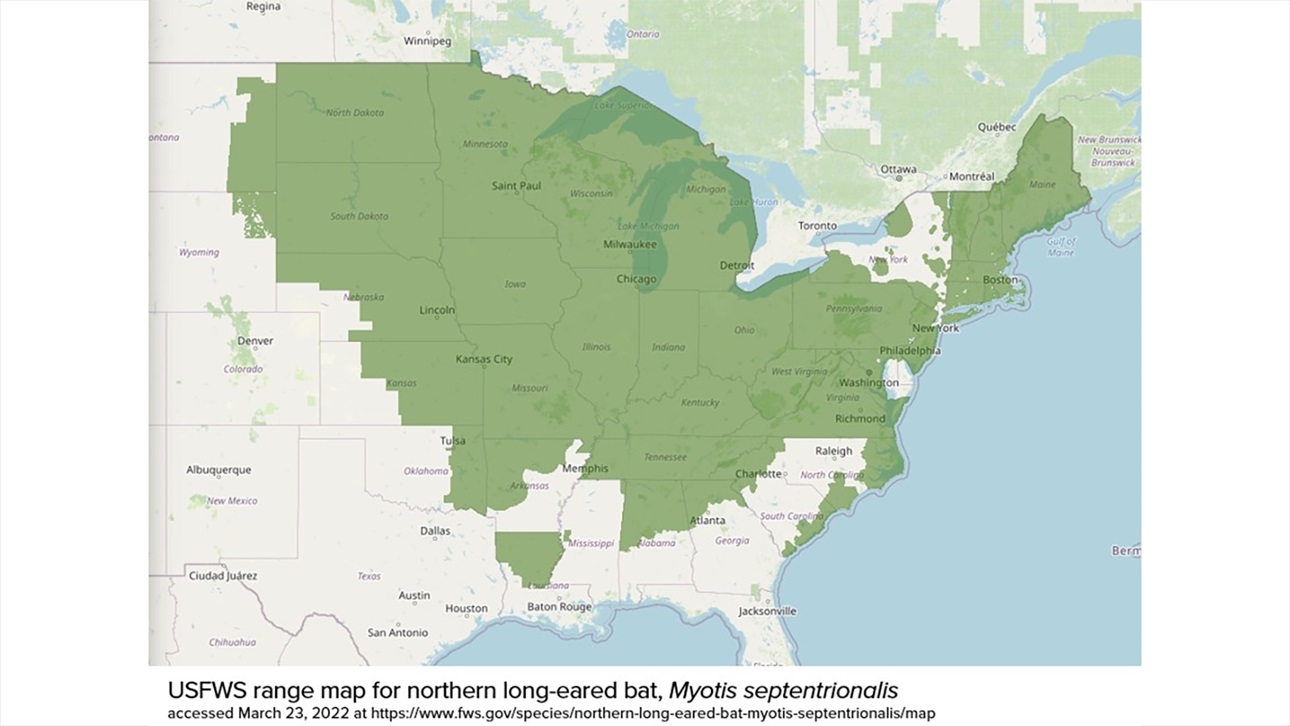FWS Delays Final Rule Re-Classifying Status of Northern Longed-Eared Bat
Less than a week before the U.S. Fish and Wildlife Service's (FWS) own deadline of today to finalize a rule reclassifying the status of the northern longed-eared bat (NLEB) under the Endangered Species Act (ESA), FWS published a notice in the Federal Register delaying the effective date for an additional 60 days until March 31, 2023.
According to FWS, delaying the effective date of the NLEB reclassification rule was necessary because of FWS' failure to finalize what NLEB species conservation measures apply to ESA permitting projects. Such measures would result in more than 24,000 ongoing ESA permitted activities involving any land clearing — such as transportation infrastructure, utility lines, municipal infrastructure and residential construction activities — occurring anywhere across the NLEB's vast habitat range (see map below) to be halted.

In 2015, FWS had listed the NLEB as a threatened species under the ESA and developed an NLEB Sec. 4(d) rule that exempted eligible activities from the ESA's Sec. 9 strict "take" prohibitions — provided those activities, including residential land development and construction, complied with the 4(d) rule's NLEB conservation measures.
In 2017, FWS finalized a NLEB range-wide programmatic Sec. 7 consultation based upon the same NLEB conservation measures contained within the 4(d) rule to authorize activities — including transportation and utility infrastructure along with residential land development — that required either a federal permit (i.e., CWA 404 wetlands permit) or received federal funding.
However, once FWS finalized its rulemaking reclassifying the ESA status of the NLEB from threatened to endangered, FWS would have to rescind the popular NLEB 4(d) rule and programmatic Section 7 consultation. The result is that NAHB members and other regulated entities are left uncertain as to what new NLEB conservation measures would apply.
Originally, FWS announced those required NLEB conservation measures would be in place before FWS finalized the current NLEB reclassification rule on Jan. 30, 2023. FWS' Jan. 26 Federal Register notice delaying the effective date of the NLEB reclassification rule gives FWS an additional two months to finalize those new NLEB conservation measures.
Last September, NAHB sent a letter to FWS urging it to announce what the new NLEB conservation measures would be before finalizing the NLEB reclassification rule. Last fall, NAHB members in the mid-Atlantic reported being informed by their Corps Districts that their pending federal wetlands permits could not be issued because the Corps did not know what NLEB conservation measures FWS would require after the rescission of the NLEB 4(d) rule.
Latest from NAHBNow
Dec 23, 2025
The 5 Types of Builders — and the One Built to ProsperMost builders want the same things: predictable profits, less stress, and a business that doesn’t grind them down year after year.
Dec 23, 2025
Lumber Capacity Has Peaked for 2025An annual revision to the Federal Reserve G.17 Industrial Production report shows current sawmill production levels above 2017 by 7.5%, but just 0.3% above 2023 levels.
Latest Economic News
Dec 22, 2025
State-Level Employment Situation: September 2025In September 2025, nonfarm payroll employment was largely unchanged across states on a monthly basis, with a limited number of states seeing statistically significant increases or decreases. This reflects generally stable job counts across states despite broader labor market fluctuations. The data were impacted by collection delays due to the federal government shutdown.
Dec 19, 2025
Existing Home Sales Edge Higher in NovemberExisting home sales rose for the third consecutive month in November as lower mortgage rates continued to boost home sales, according to the National Association of Realtors (NAR). However, the increase remained modest as mortgage rates still stayed above 6% while down from recent highs. The weakening job market also weighed on buyer activity.
Dec 18, 2025
Lumber Capacity Lower Midway Through 2025Sawmill production has remained essentially flat over the past two years, according to the Federal Reserve G.17 Industrial Production report. This most recent data release contained an annual revision, which resulted in higher estimates for both production and capacity in U.S. sawmills.
